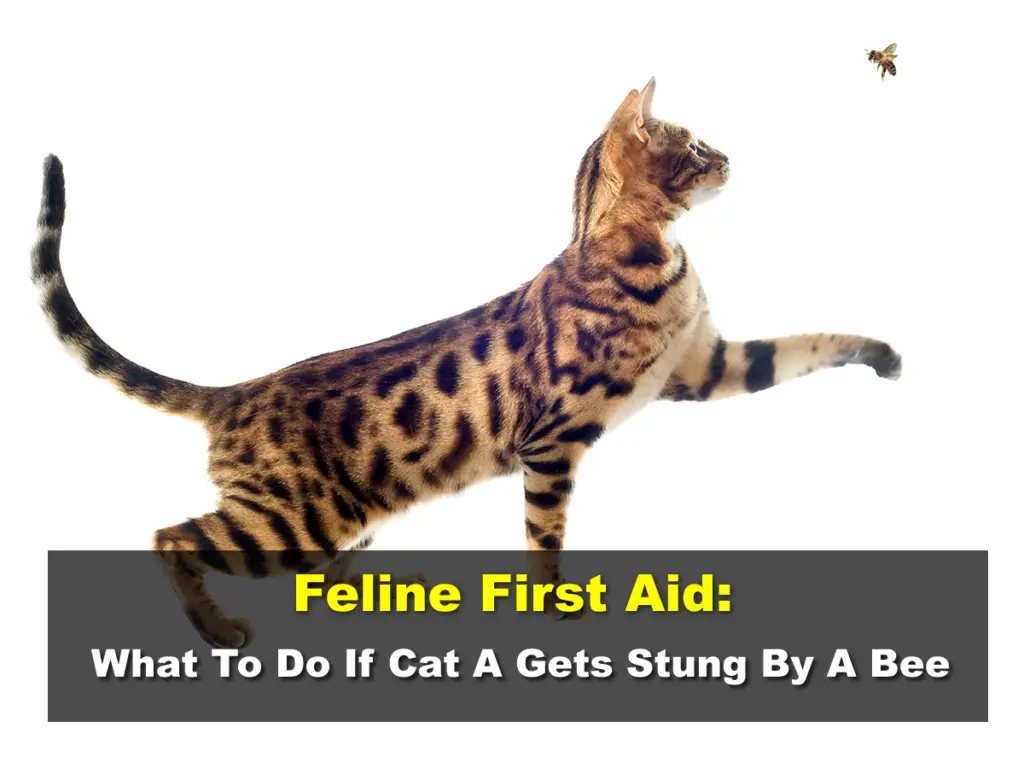Affiliate Disclaimer - As an Amazon Associate I earn from qualifying purchases.
It supports the website. So, Thank you
As a pet owner, it can be very worrying if your beloved animal’s health is compromised. Cats are incredibly curious animals and they spend a lot of time outdoors. Because of this, it’s not uncommon for them to come into contact with a whole host of other creatures which have the potential to cause them harm.
Bees are everywhere in the spring and summer so it won’t be surprising that their path may cross with that of your cat. But what do you do if your cat gets stung by a bee?
In most cases, a bee sting will cause mild pain and swelling which can be treated at home. However, some cats may have an allergy to bee stings and without treatment from a vet, this could be fatal.
If you believe your cat has been stung by a bee then it’s really important to take action as soon as possible. Even if no allergy is present, it’s still essential that you monitor your pet and provide them with relief from the pain. In this guide, I’ll talk you through everything you need to know.
Table of Contents
How To Tell If Your Cat Has Been Stung By A Bee
It may be the case that you witnessed your cat being stung by a bee in which case you can move onto the next steps. However, if you only suspect your cat has been stung then there are some signs you can look out for.
Just like humans, the majority of cats will only experience mild symptoms from a bee sting. This can include things like swelling, redness, and tenderness at the sting site. Normally, in cats, the sting will be delivered to the nose or face as your pet was probably checking the bee out and got a little too close for comfort. However, it’s also common for them to step on a bee and sustain a sting to the paw.
The first thing you should do is to check if there is still a sting in the wound. Since bees have a barbed sting, it usually remains in place until it is manually removed. Although if your cat gets stung by a wasp, this won’t be the case as the sting is not usually retained.
Another obvious sign to look out for is any redness or swelling at the sting site. Your cat may not want you to touch the area because it is painful and, if the sting is on the paw, you may notice that your cat has trouble walking. He or she may also make sounds and will likely spend a lot of time nibbling or licking the wound.
It is essential that pet owners monitor their pets after a suspected bee sting since an allergy may develop. This can show in several ways including your cat being disoriented, their body temperature lowering, or an increased heart rate. Other common symptoms of a bee sting allergy may include vomiting and diarrhea, a loss of appetite, and pale gums.
What To Do If Your Cat Gets Stung By A Bee
If you know that your cat has been stung by a bee, one of the most important things you’ll need to do is keep an eye on them for any signs of an allergic reaction. However, you can also provide at home treatment to relieve any pain or discomfort.
In the event that the stinger is still present, the first thing you’ll need to do is remove this. The most effective method is to take a credit card or any other flat-sided object and gently scrape this over the sting site which should remove it. Keep in mind that this may cause some localized pain for your cat so be aware that they may lash out.
To soothe any pain, pet owners can apply a cold compress to the area which will also help to reduce any swelling. If possible, it’s also a good idea to use a cat cone to stop your pet from nibbling the wound as this could make matters worse and potentially lead to an infection.
There are lots of home remedies that are super effective at reducing pain such as applying a mixture of bicarbonate of soda and water to the affected area. However, if you’re dealing with a wasp sting then vinegar or lemon juice tend to work better as the acid neutralizes the alkaline nature of the sting.
Steps To Take If Your Cat Has An Allergy To Bee Stings
If you already know that your cat has an allergy to bee stings then you can take action before symptoms get out of control. It is sometimes possible to offer over the counter allergy medication to your pet but I would strongly recommend checking this with your vet first. Some antihistamines can be toxic to cats and the dose may be different depending on the cat’s age, weight, and size.
In some cases, you won’t know that your cat is allergic to bee stings which is why it’s really important to look out for the signs I mentioned earlier. If you notice any of these symptoms, it is vital that you seek medical attention from your vet as soon as possible.
If bee stings are left untreated and your cat has an allergy, this could be fatal. The last thing that anyone wants is to lose their beloved pet.
Final Thoughts
Being naturally curious, it isn’t uncommon for your cat to investigate a bee when it meets one in the garden. Of course, while bees are usually aggressive by nature, they will sting if they feel threatened which may lead to your cat getting stung.
A lot of pet owners have asked me what to do if a cat gets stung by a bee and the good news is that, in most cases, this can be treated at home. Cats will react in a very similar way to humans when they’re stung and may experience pain, swelling, and discomfort. But this usually heals on its own.
There may be some cats that are allergic to bee stings and this can present with more serious symptoms like a raised heart rate, excessive drooling, vomiting, or even collapsing. If you know that your cat has an allergy or they are showing any worrying symptoms, it is vital that you have them checked by a vet. Not doing so could be fatal.




